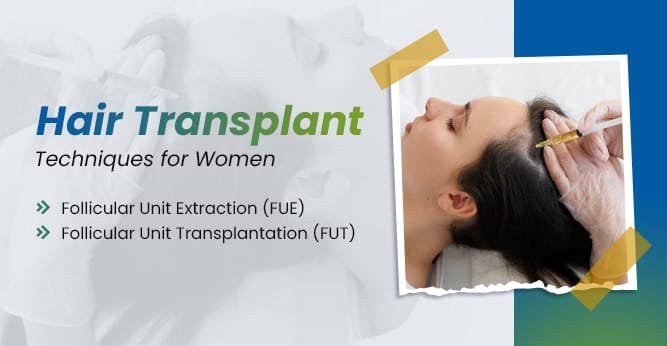
Hair loss in women is a concerning condition, where they gradually lose hair density across the scalp rather than distinct bald patches like those seen in men. Due to this difference in hair loss patterns, hair transplants for women require a unique approach. Hair transplants can offer a permanent solution for female pattern baldness and help women regain confidence and self-esteem.
Understanding Female Hair Loss
In men, hair loss usually manifests as a receding hairline or bald patches. Unlike men, women usually experience diffuse thinning across the scalp, which is often first noticeable as a widening part or a smaller ponytail.
Causes of Hair Loss in Women

Also known as androgenetic alopecia, female pattern hair loss (FPHL) is the most common type of hair loss in women. It affects around 50% of women at some point in their lives, typically beginning in the 40s or 50s. FPHL is characterized by:
- Slow but gradual thinning of hair on the top of the scalp, especially around the crown and hairline
- Widening of the part
- Receding hairline
- Reduced hair density overall
The most common underlying cause of FPHL is dihydrotestosterone (DHT), a hormone that shrinks hair follicles over time and eventually leads to premature hair loss. Hormonal fluctuations, particularly due to pregnancy, menopause, and thyroid conditions, are also some of the common reasons behind FPHL. Moreover, stress, nutritional deficiencies, certain medications, and health conditions like iron deficiency anemia or autoimmune diseases can also contribute significantly to female hair loss.
Some of the other common types of hair loss in women include the following:
- Telogen Effluvium: This temporary hair loss is often triggered by stress, illness, pregnancy, childbirth, or certain medications. It occurs when more hair than usual enters the resting (telogen) phase of the hair growth cycle and increases shedding.
- Traction Alopecia: Caused by excessive pulling or tension on the hair, traction alopecia is common among women who frequently wear tight hairstyles, such as braids, ponytails, or hair extensions. Over time, this can severely damage the hair follicles and lead to permanent hair loss if not addressed on time.
- Alopecia Areata: This is an autoimmune condition that results in hair loss in round patches on the scalp or other parts of the body. The immune system mistakenly attacks hair follicles and causes excessive hair loss.
- Scarring Alopecia: This type of hair loss occurs when hair follicles are damaged and replaced with scar tissue, often due to burns, infections, or certain medical treatments. The damage is typically irreversible, leading to permanent hair loss in the affected areas.
- Anagen Effluvium: Often associated with chemotherapy, this type of hair loss occurs when the hair follicle is damaged on a cellular level. This condition can lead to rapid hair loss during the anagen (growth) phase of the hair cycle.
If you are experiencing excessive hair loss, consult a doctor and get a thorough evaluation to understand the cause and determine the most appropriate treatment.
Read More: 9 Hair Care Myths You Need to Stop Believing Now
Types of Hair Transplant for Women

When it comes to hair transplants for women, surgeons usually recommend main techniques: Follicular Unit Extraction (FUE) and Microscopic Dissection Elliptical Excision (MDEE), formerly known as Follicular Unit Transplantation (FUT). These techniques differ depending on how hair grafts are extracted, the number of grafts that can be harvested at one time, and the type of scar they leave.
Follicular Unit Extraction (FUE)
In the FUE hair transplant for women, surgeons use a specialized punch device to individually extract hair grafts from the donor area, usually the back and sides of the head. These grafts are then transplanted into the areas experiencing excessive hair loss. This type of hair transplant for women has a faster recovery and minimal discomfort and does not leave prominent scars. However, FUE can cause small, “dot-like” scars in the donor area, which are usually easily hidden by the surrounding hair.
For women, FUE is less commonly recommended because it requires shaving the entire donor area, which is a significant aesthetic concern. However, in the long term, the benefits of FUE transplant might outweigh this initial hurdle.
Microscopic Dissection Elliptical Excision (MDEE/FUT)
In MDEE/FUT, surgeons remove a strip of skin from the donor area, from which they dissect and transplant individual hair follicles. This type of FUT hair transplant for women helps surgeons harvest a larger number of grafts in a single session, making it suitable for women who require a significant amount of hair to be transplanted. The primary disadvantage of MDEE is the linear scar it leaves at the donor site, although this scar is usually well-hidden by the surrounding hair.
The choice between FUE and MDEE/FUT depends on several factors, including the extent of hair loss, the amount of donor hair available, and the patient’s aesthetic goals. A consultation with a board-certified hair transplant surgeon is essential to determine the most appropriate technique for each case.
Hair Transplant for Women vs. Hair Transplant for Men
The methods of hair transplants for women differ notably from those of men due to the different patterns of hair loss and aesthetic goals. While men usually consult cosmetic surgeons to restore a receding hairline or fill in bald patches, women look for a more subtle enhancement and better hair density rather than drastically altering the hairline.
In addition, female hairlines are softer and less defined than their male. Consult a skilled surgeon who can carefully design the hairline to complement the patient’s facial features, creating a natural frame that complements the face.
Cost of Hair Transplant for Women
The cost of hair transplants for women depends largely on a few factors like the extent of hair loss, the number of grafts required, the transplant technique, and the clinic and its location. While hair transplants may seem expensive because of the upfront investment, the results are permanent, long-lasting, and can look remarkably natural when done by an experienced surgeon like Dr. Sidharth Sakhiya.
If you are considering a hair transplant, consult a hair transplant surgeon to get an accurate estimate and understand the long-term value of the procedure.
Female Hair Transplant Aftercare and Recovery
Post-Transplant Care
Immediately following the surgery, patients might experience some discomfort, swelling, or bruising. Dr. Sakhiya prescribes pain medications and antibiotics to prevent infection and manage any possible discomfort. You should sleep with your head elevated for the first few nights to minimize swelling. It is also important to avoid physical exertion or heavy lifting for at least a week to prevent increased blood flow to the scalp, which could dislodge the newly transplanted grafts.
Recovery Timeline
Although the recovery timeline varies from patient to patient, within the first two to three weeks, the transplanted hair usually falls out. This is a normal part of the hair growth cycle and everyone goes through this phase. The real, new growth usually begins after three to four months.
Redness and scabbing on the scalp are common in the initial weeks and gradually subside. You should avoid picking at the scabs, which can damage the follicles.
Long-term Care and Results
Most patients show noticeable results six months after their procedure, but the full results of a hair transplant can take up to a year to become evident. At this time, the hair will grow significantly, and the real density and texture will become more noticeable. Continued follow-up with the transplant surgeon is key to monitoring progress and addressing any concerns during this period.
Possible Side Effects of Hair Transplant for Women
Hair transplants for women are generally safe, especially when performed by an expert plastic surgeon like Dr. Siddharth Sakhiya at Celebre Aesthetics. However, there is a risk of some potential side effects, which may include the following:
- Mild swelling around the forehead and eyes, typically subsiding within a few days.
- Temporary itching in the donor and recipient areas as the scalp heals.
- Small scabs may form around the transplanted hair follicles, which usually disappear within a week.
- Some minor pain or discomfort in the treated areas is easily managed with over-the-counter pain relief.
- A temporary shedding of transplanted hair is a normal part of the hair growth cycle.
- Although very rare, infection can occur if proper aftercare isn’t followed.
- Minor scarring in the donor area, which is usually well-hidden by the surrounding hair.
At Celebre Aesthetics in Surat, we perform the procedure in a hygienic, state-of-the-art facility. Dr. Siddharth Sakhiya’s extensive experience in hair transplant procedures reduces the risk of side effects and ensures the best possible results.
Contact the Best Hair Transplant Surgical Clinic in Surat
If you’re considering a hair transplant and want to explore your options, Celebre Aesthetics in Surat offers expert guidance and state-of-the-art treatments tailored to your needs. Our team of experienced professionals is dedicated to helping you achieve the best possible results with personalized care and attention. By booking a consultation with us, you’ll receive a thorough assessment, clear explanations of the available procedures, and answers to any questions you may have. Take the first step towards restoring your confidence—schedule your consultation with Celebre Aesthetics today.







